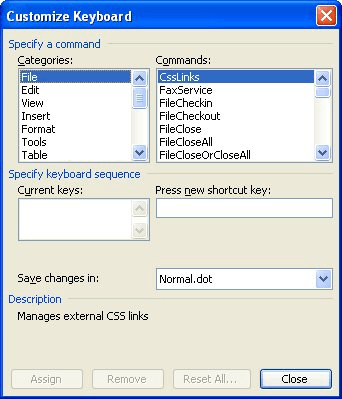Please Note: This article is written for users of the following Microsoft Word versions: 97, 2000, 2002, and 2003. If you are using a later version (Word 2007 or later), this tip may not work for you. For a version of this tip written specifically for later versions of Word, click here: Assigning a Shortcut Key to Styles.
Written by Allen Wyatt (last updated December 11, 2021)
This tip applies to Word 97, 2000, 2002, and 2003
In other issues of WordTips you learn how to add styles to your document. Word also allows you to assign shortcut keys to styles. These shortcut keys can then be used to quickly apply styles to various paragraphs in your document.
The steps you use to define a shortcut key for a style depend on the version of Word you are using. To define a shortcut key, do this if you are using Word 97 or Word 2000:
The steps you follow are a bit different if you are using a later version of Word:

Figure 1. The Modify Style dialog box.

Figure 2. The Customize Keyboard dialog box.
WordTips is your source for cost-effective Microsoft Word training. (Microsoft Word is the most popular word processing software in the world.) This tip (592) applies to Microsoft Word 97, 2000, 2002, and 2003. You can find a version of this tip for the ribbon interface of Word (Word 2007 and later) here: Assigning a Shortcut Key to Styles.

The First and Last Word on Word! Bestselling For Dummies author Dan Gookin puts his usual fun and friendly candor back to work to show you how to navigate Word 2019. Spend more time working and less time trying to figure it all out! Check out Word 2019 For Dummies today!
You can easily use regular editing techniques to copy styles from one document to another. Here's how to make quick work ...
Discover MoreThe basis of almost all styles in Word is the Normal style. Here's a good reason why you shouldn't use it.
Discover MoreStyles are a fantastic tool for formatting documents. As you work with documents created by others, you may want to get ...
Discover MoreFREE SERVICE: Get tips like this every week in WordTips, a free productivity newsletter. Enter your address and click "Subscribe."
There are currently no comments for this tip. (Be the first to leave your comment—just use the simple form above!)
Got a version of Word that uses the menu interface (Word 97, Word 2000, Word 2002, or Word 2003)? This site is for you! If you use a later version of Word, visit our WordTips site focusing on the ribbon interface.
Visit the WordTips channel on YouTube
FREE SERVICE: Get tips like this every week in WordTips, a free productivity newsletter. Enter your address and click "Subscribe."
Copyright © 2025 Sharon Parq Associates, Inc.
Comments